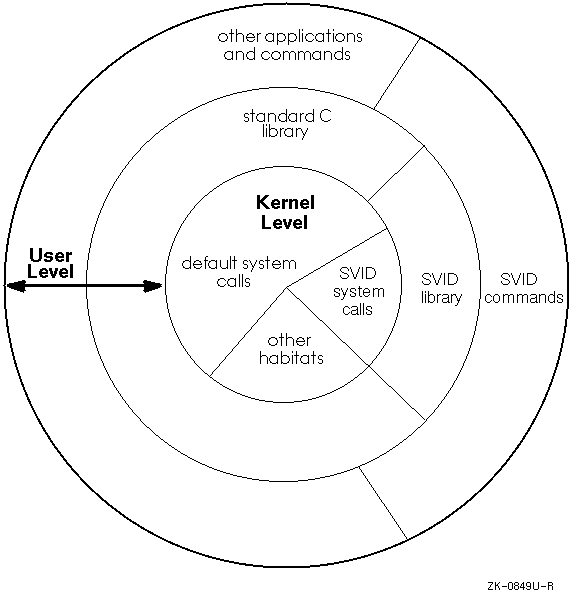The System V habitat consists of alternate versions of commands, subroutines, and system calls that support the source code interfaces and runtime behavior for all components of the Base System and Kernel Extension as defined in the System V Interface Definition (SVID). This implementation of the System V habitat supports all SVID 2 functions and SVID 3 functions. Note that the System V habitat does not contain alternate versions of default system commands, subroutines, and system calls that already meet the SVID requirement.
Using the System V habitat lets you override the default system commands and functions with corresponding System V commands and functions (system calls and subroutines). You can access the habitat in two ways:
Because the System V system calls are not layered over the system calls in the default system, applications that are built using the system calls in the System V habitat run with virtually no performance overhead. Figure 9-1 illustrates the System V habitat placement within the default operating system and shows that the System V system calls reside at the kernel level.

The following sections describe how to set up your environment to access the System V habitat and how it works.
To automatically access the System V habitat when you log on, you must add a command line to your .profile file if you use the Bourne or Korn shell, or to your .login and .cshrc files if you use the C shell. The command line modifies the PATH environment variable, which causes the System V habitat to be searched before the standard default locations on the system are searched, such as /bin or /usr/bin. The System V habitat scripts are as follows:
Specifies SVID 2 behavior when placed in either your .profile or .login and .cshrc files, respectively.
Specifies SVID 3 behavior when placed in either your .profile or .login and .cshrc files, respectively.
For example, if you use the Bourne or Korn shell and you want to specify SVID 2 behavior, edit the .profile file and add the following command line:
if [ -f /etc/svid2_profile ]
then
. /etc/svid2_profile
fi
If you use the C shell and you want to specify SVID 2 behavior, edit the .login and .cshrc files and add the following command line:
if ( -e /etc/svid2_login ) then
source /etc/svid2_login
endif
The dot (.) and source commands are shell-specific. See the appropriate reference page for more information.
Whether you choose the script that specifies SVID 2 behavior or the script that specifies SVID 3 behavior, both establish the System V habitat as follows:
Hence, if you need to determine the location of the System V habitat on your system, run the cat(1) command on the /etc/svid2path or /etc/svid3path file.
By using the System V habitat scripts to alter the PATH environment variable, the System V habitat path can be changed without an administrator updating each user's .profile or .login and .cshrc files. The administrator simply updates the /etc/svid2path and /etc/svid3path files to enable global definitions.
To further illustrate how the System V habitat script sets a PATH, look at the following .profile file which specifies the System V habitat script for SVID 2:
stty erase DEL kill ^U intr ^C quit ^X echo
TERM=vt100
PATH=:$HOME/bin:/usr/lib:/bin
MAIL=/usr/mail/$LOGNAME
EDITOR=vi
export MAIL PATH TERM EDITOR
if [ -f /etc/svid2_profile ]
then
. /etc/svid2_profile
fi
In this example, assume that the path of the System V habitat is /usr/opt/s5 as reflected by the contents of /etc/svid2path and that your login directory is /usr/users/xxx. When you display the PATH after logging in with the preceding .profile file, the result would show that the path to the System V habitat has been prepended to the PATH set in the third line of the .profile file as follows:
%
echo $PATH [Return]
/usr/opt/s5/bin:/usr/opt/s5/sbin:/usr/users/xxx/bin:/usr/lib:/bin
Hence, when you issue a shell command, the System V habitat is searched first. If the command is not found, the specified paths are searched.
Compatibility for your shell scripts is achieved by altering your shell's PATH environment variable (as explained in Section 9.1). Therefore, the System V habitat is searched before the default system locations. If your PATH variable is set for the System V habitat, your scripts are System V compatible regardless of whether you use the Bourne, Korn, or C shell.
Table 9-1 summarizes the behavior of user commands in the System V habitat that have options or features that differ from the default system versions. For a complete explanation of the commands in the habitat, refer to the reference page for each command.
| Command | System V Behavior |
| chmod(1) | Ignores the umask value when the who string is omitted, behaving as though a is the who value when you use the symbolic form of this command. |
| df(1) | Accepts the -t option, which prints space totals, and accepts an optional file system name or device name. |
| ln(1) | Accepts the -f option, which silently removes existing destination pathnames before creating the specified link. |
| ls(1) | Produces multicolumn output only if the -C option is specified. Also, the -s option causes file sizes to be reported in 512 byte units instead of 1024 byte units. |
| mailx(1) and Mail(1) | Includes the capabilities of the System V mailx command. |
| sum(1) | Uses the word-by-word algorithm by default; uses the byte-by-byte algorithm if the -r option is specified. The default use of the checksum algorithms for the System V sum command is the reverse of the default system version of the sum command. |
| tr(1) | Includes the -A option whenever you specify the -c option. The -A option causes only the characters in the octal range of 1 to 377 to be complemented. |